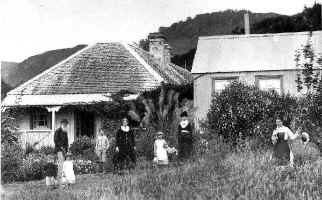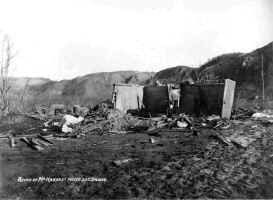![]()
Home | Author's Note | Archifacts Review | Newspaper Review | Order Forms | Links
Newspaper
Review
Page 28-Otago Daily Times, Wed., October 12, 1988
Drama and documentation of a unique disaster
By George Griffiths, Book Editor
Though publishing in all developed countries inevitably becomes an industry dominated by market considerations, it is always a great pleasure to see a fine "amateur" book issued by a sturdy independent.
It can be a novel as The Bone People was: or a handsome photographic study, like the Potton/ Dennis Images from a Limestone Landscape: or the astonishing 528pp Domesday Book, Land of Many Hills, which Paula Dickie wrote about one small district of Eastern Southland.
Those are three recent examples of "amateur" New Zealand publishing in the original sense - labours of love. Such books, when done well, earn a lasting respect from librarians and book collectors.
Tarawera: The Volcanic Eruption of 10 June 1886 by Associate Professor R.F.Keam, of the Auckland University physics department, is one of the most impressive amateur books ever to have been issued in this country.
It is a large 4to volume of 472pp, well bound in blue buckram and posted out (sales are by mail-order Only) in a strong specially designed carton. The Cometti cover (more suitable than at first appears, for it is a little garish) has the effect of recalling the equally garish contemporary chromo-lithographs issued after the eruption first occurred.
But it is the black-and-white illustrations which really take the eye. We may have seen many of them before - several, indeed, were in Geoff Conly's book on the Tarawera eruption published a couple of years ago - but never in such luxurious presentation. They have been reproduced by the expensive duotone process, rarely used for books in which text predominates, by which the photographs are scanned into two separations for grey and black and have to be printed on a multi-colour press.
INEXORABLE
The pre-eruption shots of the Terraces, the blackened landscapes, the drunken ruins of hotels and the motley groups of survivors are all so fresh and magnificent that one is immediately drawn in to begin reading the book.
And that, too, is quite an experience. To Keam, Tarawera has been a consuming interest, if not a passion, for more than 40 years: and in that time he has steadily accumulated all the possible relevant information he can lay his hands on, presenting it here not only in the form of a narrative, but also as the complete reference to the subject.
One would not recommend anyone to try reading it at a sitting. Nevertheless, the book has a considerable dramatic structure to it - fresh again because Keam, the professional scientist, approaches the historical and journalistic aspects of his work as a dedicated amateur. He builds up the story in the innumerable short logical sections of a scientific thesis (the illustrations are even numbered in the thesis manner), taking the reader inexorably on, step by step.
SCENE SET
We are given a thorough description of normality in the thermal area in the years immediately preceding the disaster - the first European ascent of Tarawera; the development of the tourist industry around the Pink and White Terraces; the highly active role of the Maoris in that industry and the financial benefits they enjoyed-, the creation of a planned township at Rotorua to rival and outshine Ohinemutu; European settlement around Wairoa; problems of Maori health there…so that, after the first 70pp, the reader has a good feel of the circumstances.
The Haszard family outside their Te Wairoa schoolhouse a few months before the eruption
This is important, for popular legend has it that the Wairoa area knew all kinds of strange events and incidents before the disaster struck. Keam shows quite clearly that much of this was sheer retrospective embroidery: the patterns of prior quakes, lake surges and the rest were not particularly different from what that active area generally experienced, and no one thought them worth acting upon at the time they occurred.
The sighting of the phantom canoe is documented in considerable detail and allowed to speak for itself. Again much of the subsequent embroidery can be stripped away, but the cause of the sighting is left open to conjecture.
HOMING IN
Then comes the explosion. We are introduced to it in Christchurch, of all places, as a dull thud and a touch of lightning in the northern sky. At Kaikoura it was like the boom of a gun; at Blenheim, thunder out at sea; around the Wellington area, perhaps the suspicious visiting Russian warship, the Vestnik treacherously shelling a coastal port.
And so Keam takes us gradually nearer and nearer the eruption until, at Tauranga, the residents hear the nerve-wracking explosions, see the vivid and continuous lightning, and suffer the heavy fall of ash and sulphurous dust that went on for several hours. The added weight of documentation from places like Te Puke and Ohinemutu conveys to the reader in a necessary manner the sheer scale and horror of the disaster as the narrative moves ever closer to the epicentre.
With that preparation, the ordeal of those at Wairoa, -though so often told before, takes on a still sharper focus. The climax of the book, even if it comes only about one-third of the way through, is Mrs Amelia Haszard's account - having been dug out hours afterwards from apparent certain death - of the crushing irresistible force of the ash and the mud, and her awareness of other members of her family dying around her in their overwhelmed schoolhouse. Never again does one wonder why flight from a volcanic eruption - be it at Wairoa or Pompeii - is so impossible.
The ruins amid the ensuing desolation. Five of the family died; three survived
Then comes the aftermath - detailed descriptions of the rescue expeditions (one party reported going 15km without seeing a single green leaf), which themselves were not without courage and danger; the debates over the efficiency of government assistance; jealousies among the organisers and participants; the influx of journalists and, later, professional photographers; the dispatch of New Zealand's top scientists to the scene, and their later disagreement over what they found.
Much of this is simply documentation, though the astonishing survival of the tohunga Tuhoto Ariki is a story in itself (particularly as the disaster was attributed in some quarters to his witchcraft); there is a thorough examination of the effect of the disaster on the local Maoris; Dr Hector's professional standing comes out of it rather badly; and some of those who did most to help their fellow humans in the darkest hours had little to show for it later but debts and bankruptcy.
EXPERTISE
Keam leaves the geological and physical assessments to the end of the text - and, as so often happens when people move back into their field of professional expertise, be loses a little of that carefully lucid exposition he had used in the "amateur" chapters. A professional becomes so used to his subject that he tends to forget how an ignorant layman would like to approach it, even when he is spelling it out in detail.
But the information is there and on the key question - Do the Terraces still lie buried below? - Keam is surprisingly open-minded. Perhaps it is the dream of their possible survival which has fired the long years of his research.
One might think a large 350pp book coverage enough, but there are still 50 pages of appendices to follow, and then a meticulous bibliography and index - and even vague mention of a companion volume, whatever that might turn out to be. Both as narrative and as reference this is a monumental work.
COMMITMENT
Its production has been on the same scale. No reason is given why this book missed its natural publication date on the centenary of the eruption (amateurs have a tendency to be quixotic about timing - which, in publishing, is just as important an art as anything else) but in other respects Professor Keam brooked no error.
He mortgaged his house, I’ve been told, to carry the venture through; spent most of a year preparing the illustrations with the Auckland firm of Star Graphics (which has done a marvellous job with them); then camped himself behind the presses of a local printing firm (the whole process has been done in Auckland) to check every sheet as it came off the plates.
I rather suspect that he even did his own final paste-ups, for quite a number of pages carry orphaned half-line turnovers - usually taboo to professional publishers even in today's relaxed times. And the many passages of quotation would probably have looked better indented only on the left-hand side. Even so, the book must be a candidate for next year's production prize.
Finally, probably compelled by the sheer cost of the operation, he has not used conventional distribution, but is marketing the total edition himself from the Physics Department, University of Auckland.
The price, posted, to anywhere in the South Island is [NZ$228]- daunting enough, though only a dollar more than my last double visit to the dentist -- In Auckland and the Rotorua district, I understand, the book was well enough received for the author to pay off his mortgage within a month of publication.
It has taken several more months for a review copy to reach south beyond Tarawera's direct range - although it was a Dunedin family, the Sises, who were among those who saw the mysterious canoe on the last tourist outing before the eruption; and, of course, Burton Bros made considerable photographic capital out of the event.
The wait has been worthwhile. It is a notable book: not as stylishly written as Tutira, but fit to rank with it as a classic of its kind, and entirely appropriate to its subject - far and away the most dramatic natural disaster in New Zealand's history.
Home | Author's Note | Archifacts Review | Newspaper Review | Order Forms | Links
Send mail to r.keam@auckland.ac.nz with
questions or comments about this site or to inquire about ordering
Tarawera and/or Dissolving Dream.

